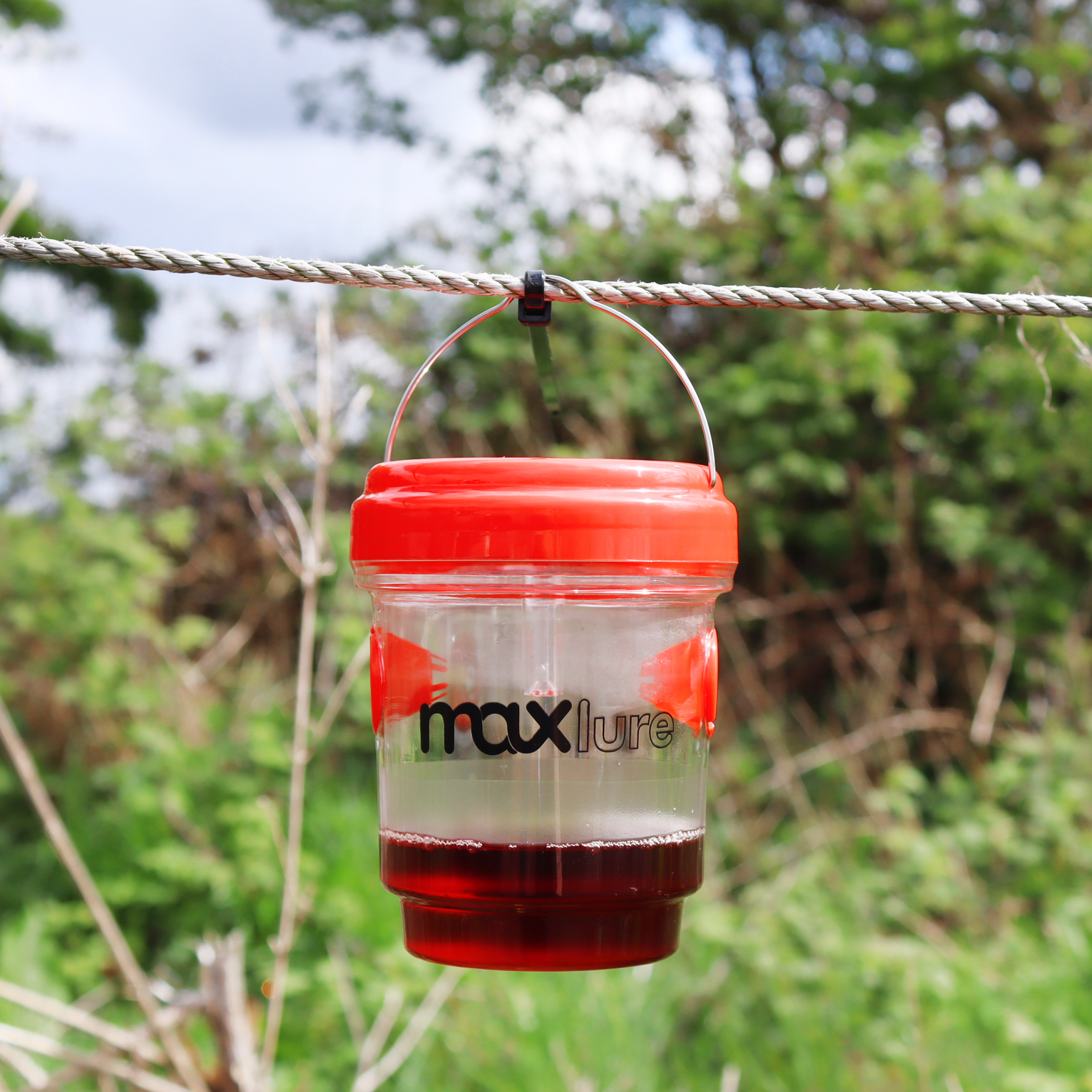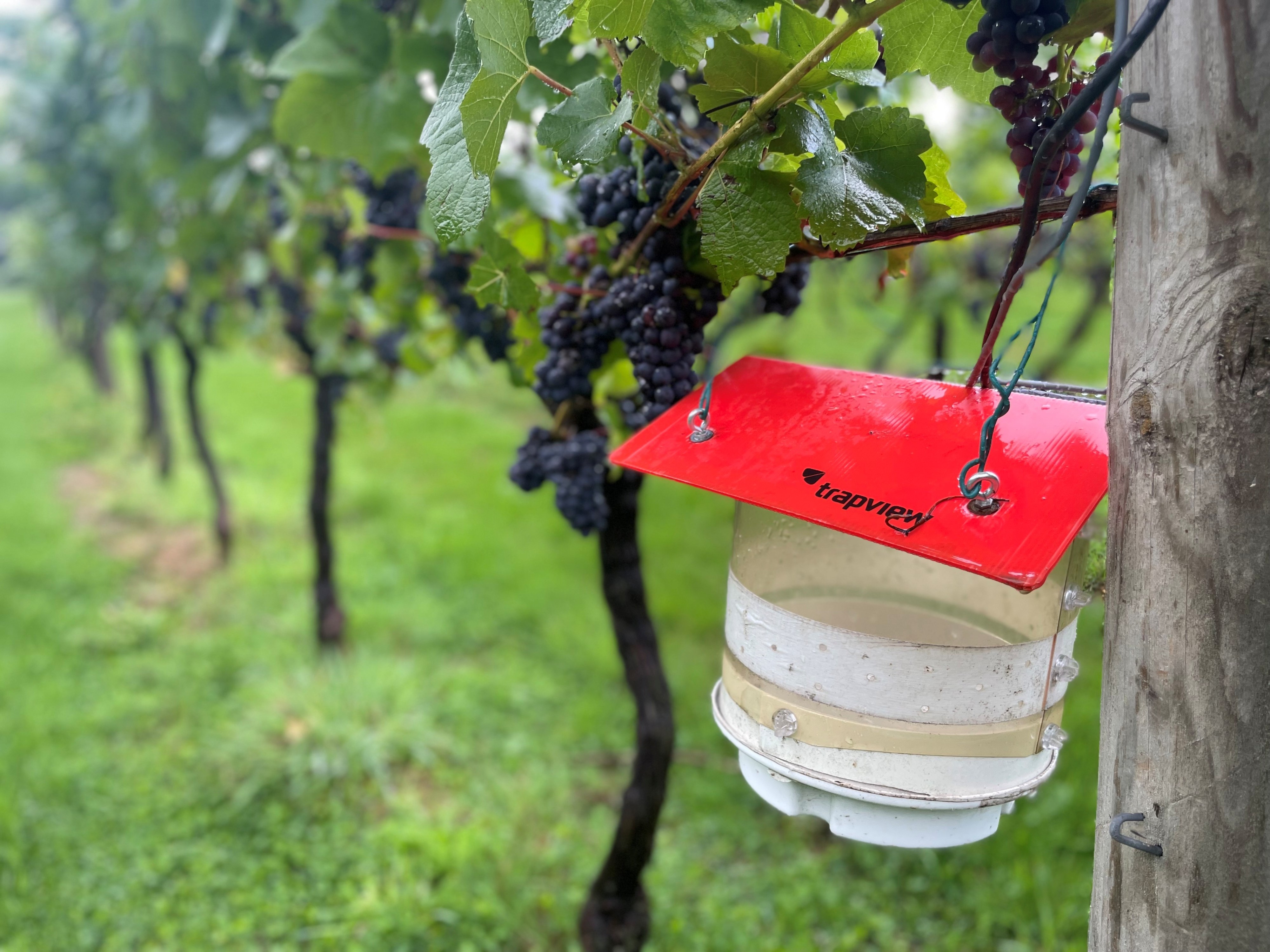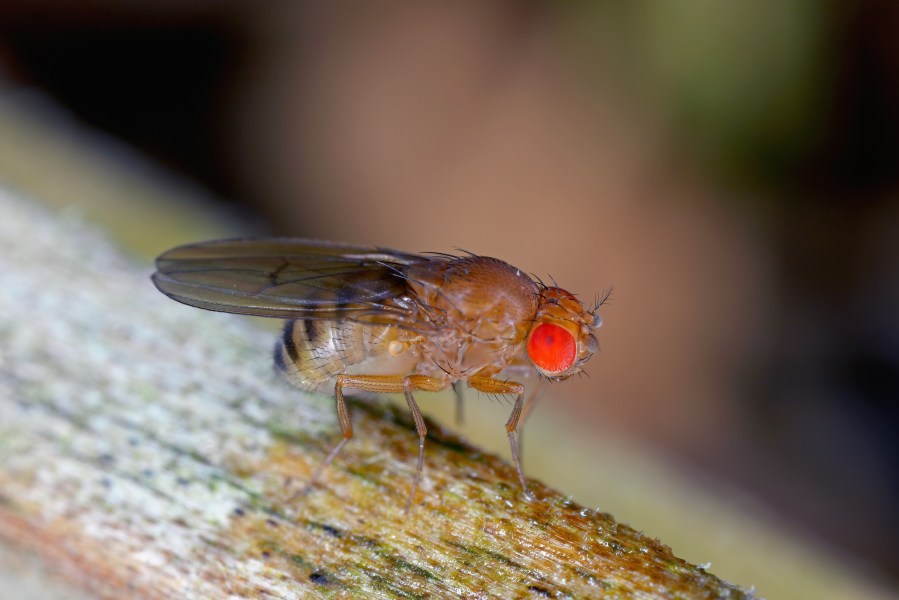Spotted Wing Drosophila is an invasive fruit fly first reported in the UK in 2012. It was identified at the NIAB’s East Malling site in Kent and has begun to represent an increasingly serious risk to crops in England and Wales.
The winged pest, Spotted Wing Drosophila (SWD), hails from Japan and has gradually spread worldwide, targeting soft fruit crops. The transportation of contaminated fruit was the mechanism that allowed the species to cross continents and find new territories.
Unlike Drosophila melanogaster, the common fruit fly found in the UK, Drosophila suzukii is attracted to underripe fruits as well as the ripe and overripe, so it can attack crops both before and during harvest. It has been found across habitats and in a wide range of plant species, including wild blackberries, which helps to explain why it has spread so easily. It is now well established in both woodland areas and cultivated plant hosts. If SWD populations remain uncontrolled, this pesky fly can cause entire crops to be lost.
The decision was taken not to make SWD a notifiable pest in 2012. The EU Standing Committee on Plant Health agreed that due to the nature of the fly’s biology and life-cycle it was unlikely that official phytosanitary measures would help to prevent further spread.
Although different species of Drosophila larvae cannot be identified on sight, the adults have characteristics that can be seen with the naked eye or with a magnifying glass. It is worth keeping an eye open for SWD when walking the vineyard, paying particular attention to the fruit where they land to mate or lay eggs.
Males have a large spot along the front of each wing, which is bold and distinctive. Females can be recognised by their unusual serrated ovipositor, which may need to be identified through the use of a lens. Located at the base of the abdomen, the saw-like teeth on this appendage allow them to penetrate the skin of the fruit to deposit their eggs. Other species of the Drosophila family do not have this and must lay their eggs in overripe or rotten fruit, where the skin has already been breached.
Red wine grapes are most often attacked when veraison begins, but white grape crops are at risk too, when their sugar levels are high enough. As well as damaging the fruit through piercing the skin and the action of the larvae feeding, SWD attack increases the risk of secondary infections like Botrytis and sour rot.
Population size can increase rapidly. Depending on the temperature, SWD takes a week or two to mature into adulthood, and a single SWD female can lay up to 900 eggs in her adult life. This is why early identification is paramount, and why this occasional pest may become more of a feature in our vineyards as the climate slowly warms.
Year round monitoring is important
The adult Spotted Wing Drosophila overwinters to parent the next generation in the summer. They take a different form in the winter that is better able to withstand cold weather. While the adults fly during mild periods in the winter and spring, they will only lay eggs between May and October. Populations build as the temperature warms, and if they go unmanaged they can reach a peak at the same time as the grape crop moves towards ripeness.
This lifecycle means that year round monitoring of SWD is important so that control measures can be applied swiftly and effectively whenever they are needed. Populations can be attacked and reduced in the winter. Where the flies get through to infect crops, they can be treated, as far as is practicable, to attempt to minimise the damage during the growing season.
There were reports of some fairly large-scale SWD outbreaks causing damage to a number of UK vineyards in the 2023 season, at the end of a relatively long hot summer that created the perfect conditions for their proliferation. Many growers were relieved to find that last year there was a lot less damage, but experts believe that this may be a false assurance. It is suggested that SWD populations were just as high in 2024, but with a relatively cooler summer season the same peak in activity was not observed.
Therefore, vineyard managers are warned not to let their guard down. So far we have experienced a dry, warm spring and the summer is expected to continue that trend – giving SWD just the conditions they need to proliferate again. Forewarned is forearmed, and this is where a cohesive monitoring strategy comes into its own.
Monitoring: Russell IPM and TruePest
Andrew Russell from Russell IPM explains how they are harnessing the power of AI to improve the quality of SWD monitoring.
Their technology, TruePest, was initially developed with soft fruit growers in mind, but it has equal application in vineyards.
How was TruePest developed?
Previously to conduct accurate monitoring a team would go around the set points using a bucket trap where they take the catch in, analyse it through a microscope and get accurate counts from it. That cost more than £500 per trap per year. To operate a team for the whole season with the correct expertise was very expensive. We were looking at what technologies can be employed to make that identification quicker, easier and cheaper.
We were involved in Innovate projects as an industrial partner with Berry Gardens, East Malling and others over a number of years to look at different ways of improving the monitoring of SWD. One project was trying to develop a static camera type set up. And coming out of that we really thought that it wasn’t really a viable product – the capital cost per unit at the time was just too high and it wasn’t something that you could deploy at scale on a farm.
You don’t take one soil sample out of the middle of one field, for example. You want a lot of monitoring points in order to get an accurate picture of what’s going on. So we wanted something that we would be able to deploy at scale. We took the work that Durgham Al-karawi, (Head of AI at Russell IPM) had done to develop the AI algorithm and put it into a mobile phone application. We created TruePest, an AI driven system for monitoring SWD.
There is a lack of people who are skilled [at SWD identification] out there in the industry, and even if you have someone, you could probably employ them better than having their head in a bucket. With our system, you can give them the data and their skills can be better utilised in your organisation.
What does TruePest do?
TruePest is a combination of a mobile phone app and a modified trapping point that you deploy in the field and a web portal. The heavy capital cost bit of it is something that most people already have sat in their pockets now.
You take the reading using your phone and it will give you the count straight away in terms of males and females. It will also fire that data up to the cloud so you have got it accessible to the team and further diagnostics on the system as well.
When you start to take pictures it also gives you a GPS of where each trap is, so then you get a heat map across the whole property with green indicating a number below the threshold and red showing that levels have reached the threshold capacity you have set. We give growers the option to set their own threshold because that can be different across the different types of crops that are grown, and it might change throughout the year as well.
If you are using the recommended type of phone, which is iPhone 13 Pro and above or Samsung S21 and above, you should achieve 90% accuracy.
How does it work in practice?
You just scan the QR code on the trap, use the lock on your camera and take a picture of the two boxes. In last year’s beta test we used a yellow trap, now we’re using a red one. We knew that red was a more attractive colour to SWD but we had not found the right shade to work well with the phone until now.
There is a dashboard on the website that shows you how many traps you have deployed in any field block and how many of those have been looked at during the last seven days. There is an average trap count available for your chosen species, so you can select male, female or total SWD. And you can keep on going down to the individual trap information.
It is quite accessible and intuitive, particularly if you are managing a team across a number of different locations, to look very quickly at what the situation is on those sites. Typically people are monitoring on a weekly basis. The system has a small lockout to stop you double scanning on the same day.
You don’t need to change the trap every time either. It has a maximum loading, so if it is not full the app will let you know that you can come back and take a reading from it again next week. Realistically at the beginning of the season they might last one to three weeks, and by the end of the season will probably need changing weekly.

Monitoring: Landseer and Trapview
Steven Tully from Landseer Ltd explains why SWD poses such a significant threat, and how trapping can help to protect your crop.
Can you explain why SWD is an issue for vineyards?
Spotted Wing Drosophila (SWD) poses a significant and growing threat to UK vineyards, especially when not actively monitored or managed. Unlike many other fruit pests, SWD lays its eggs inside ripening, soft-skinned fruit, making grapes particularly vulnerable. The resulting larval development occurs rapidly within the fruit, leading to internal collapse that often impacts cluster quality (e.g. acidity and Brix levels).
Adding to the severity of the issue is the potential for secondary infections. The puncture wounds created by SWD as they lay eggs serve as entry points for pathogens, which can lead to fungal or bacterial infections that spoil entire bunches (Botrytis). This not only compounds the direct damage caused by the pest but significantly affects both yield and fruit quality. This damage can be devastating as it typically occurs just as the fruit reaches veraison and nears harvest – potentially undoing an entire season’s work and investment in a matter of weeks.
The threat from SWD has undoubtedly increased in recent years. The pest has now become established in much of the UK, and its populations appear to be both spreading and fluctuating year on year. Warmer growing seasons and increasingly variable weather conditions have further influenced pest pressure and grape susceptibility. Grapes, being a late-season crop, are particularly exposed when alternative food sources such as wild berries are limited, making them a prime target during peak pest activity.
How can this problem be managed?
Complicating matters further, our available tools for control are shrinking, with fewer active ingredients approved for use. This makes proactive management even more essential. Monitoring and early detection must be seen as critical components of a successful strategy. By the time visible or olfactory signs of infestation are noticeable in the vineyard, the problem is already well advanced. Implementing smart trapping systems, maintaining strict vineyard hygiene, and staying up to date with local pest pressure reports are all key to managing this increasingly problematic pest.
What kinds of traps are available?
There are two main types of traps used in vineyards, manual and smart remote traps.
Manual traps
These typically consist of a cup with a liquid attractant that lures SWD. The contents are poured through a filter and then examined to identify SWD among many other insects. While effective, this method is labour-intensive, time-consuming, and requires regular checking and specialist identification skills – often during the busiest parts of the season. Identifying SWD can be a time-consuming task. While males are relatively easy to recognise thanks to the distinctive spots on their wings, confirming the presence of females is more challenging and typically requires the use of a hand lens or microscope to detect their serrated ovipositors.
Remote, smart traps
These work on the same principle, using an attractant and a sticky plate instead of a filter. A built-in camera takes high-resolution images of the sticky surface daily, and AI technology automatically identifies and counts male SWD. This information is then relayed directly to your phone or computer, with optional alert settings to flag when thresholds are met.
Smart traps significantly reduce the time and labour needed for monitoring, allowing vineyard managers to focus on other essential tasks while staying continuously informed. They provide faster, more accurate insights, helping to make timely and effective decisions about control measures.
Ultimately, trapping – especially when automated – helps growers stay proactive rather than reactive, making it a key tool in protecting valuable crops at the most vulnerable time of the season.
Can you tell us a little more about the smart traps offered by Landseer?
When it comes to remote, smart traps in the UK, one of the most established and effective options available to vineyard managers is Trapview, distributed by Landseer. Landseer has worked with Trapview for over a decade across other crops – particularly top and stone fruit – its use in vineyards is now growing steadily in response to the increasing pressure from SWD.
Trapview is an automated, solar-powered smart trapping system, developed in Slovenia and now used globally. It provides growers with daily high-resolution images of a sticky trap surface, which are analysed using artificial intelligence to automatically detect and count SWD. These images and pest count data are uploaded in real-time to a user-friendly web and mobile platform, giving vineyard managers photographic evidence and up-to-date insights into pest pressure.
An additional feature of Trapview is the integration of pest monitoring with microclimate data collection. Each unit includes built-in temperature and humidity sensors, enabling the platform to use population forecast modelling, including degree day tracking, to predict likely SWD activity and development. This allows for data-driven decision-making and more precise timing of any intervention.

For more like this, sign up for the FREE Vineyard newsletter here and receive all the latest viticulture news, reviews and insight




